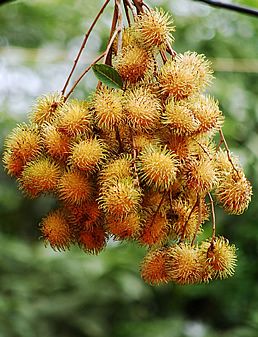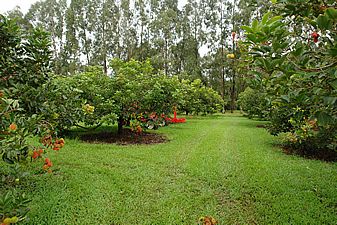
The rambutan (Nephelium lappaceum) is a perennial and dioecious tree native to the Malay Archipelago and cultivated in various tropical regions for its exotic, fragrant, and tasty fruits. Belonging to the Sapindaceae family, it is related to the Lychee (Litchi chinensis) and Pitomba (Talisia esculenta).
It has a tall stature, reaching heights of 40 to 66 feet (12 to 20 meters), with a wide and sprawling crown. Its leaves are alternate, pinnate, with three to eleven glossy and elliptical leaflets. The rambutan tree can be male, displaying exclusively male flowers, hermaphroditic, with female flowers and a small percentage of male flowers, or female, bearing only functionally female flowers.
The inflorescences are panicle types, with numerous small, greenish flowers of little ornamental importance. Bees, ants, and flies are the main pollinators of the species, which in some areas bears fruit up to twice a year, once at the end of autumn and again at the beginning of summer.

The fruits are fleshy drupes, formed in clusters, with white and translucent pulp, and a peel that can vary in shades from yellow to dark red. The peel is covered with soft spicules, making it resemble a small hedgehog. This peel also contains a toxic saponin and should be completely removed when enjoying the fruit.
The fruits should be harvested ripe, as they do not ripen after being picked. The pulp is sweet, juicy, aromatic, and slightly acidic, rich in vitamin C. It is generally consumed fresh, in natura, but can also be cooked for preserves. Each fruit contains a single brown and flattened seed. When roasted, the seed is also edible and rich in both saturated and unsaturated fatty acids.
The rambutan tree is a very interesting addition to the domestic orchard in warm regions. It is hardy, requiring little maintenance, and provides ample shade throughout the year. Its fruits are not only beautiful but also tasty, enhancing any menu. In the Brazilian market, due to limited supply, they command high prices in major consumer centers.
Nevertheless, a rambutan tree laden with fruit is of high ornamental value, enhancing the landscape design of large areas. It requires only formative pruning to prevent excessive height growth and to encourage lateral branching. It does not tolerate transplanting well, so it is better to plant seedlings in their final location rather than moving them from pot to pot as they grow.

Rambutan trees should be grown in full sun, in fertile, well-drained, deep, slightly acidic soil enriched with organic matter. As a typical tropical tree, it thrives in heat and humidity. It does not perform well in regions with climates prone to temperatures below 50°F (10°C). Once well-established, it can tolerate short periods of drought, although it prefers constant rainfall. Fertilization is beneficial during growth and fruiting periods.
Propagation can be done by seeds, cuttings, air layering, budding, and grafting. Seed germination is straightforward: simply depulp the ripe fruits, wash them under running water, and sow immediately in sandy, moist substrate. Rambutan seeds lose their germination capacity if stored. Germination can take 7 to 30 days. Plants grown from seeds are larger, longer-lived, later in fruiting, and it is not possible to predict the quality of the fruits. Furthermore, half of the plants will be male, i.e., not fruit-bearing.
Vegetative propagation methods allow for uniform plants of known quality, reduced size, and early bearing. Cuttings achieve success when rooting hormones are used, with a success rate of 30 to 70%. The most interesting method for commercial orchards is grafting, particularly budding. Plants produced this way can begin fruiting in about two to three years after planting, whereas those grown from seeds may take 5 to 6 years. The recommended spacing between seedlings varies from 20 to 33 feet (6 to 10 meters) between plants and rows.


